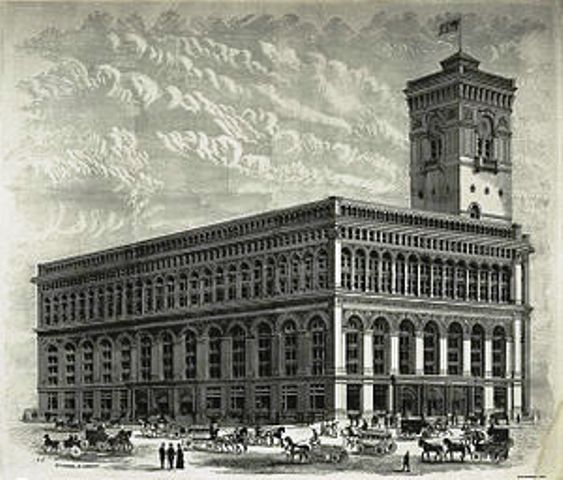
From 1897 to 1953, the New York City Post office used an intricate pneumatic tube system to move mail across the city. At the peak of its operation, the tubes carried around 95,000 letters a day, which was about 30% of all the mail routed daily in New York City.
Put into operation by the New York Mail and Newspaper Transportation Company (a subsidiary of the American Pneumatic Service Company), the 27-mile system connected 22 post offices in Manhattan and the General Post Office in Brooklyn. The cast-iron tubes ran 4 to 12 feet underground; in some places they ran along the NYC subway IRT tunnels along the Lexington Avenue line (4, 5 and 6 trains).
The system used 25-pound steel cylinders that were 21 inches long and 7 inches in diameter to transport first-class letters as well as second-, third-, and fourth-class items such as clothing and books. The canisters were shot through the 8-inch diameter tubes via air pressure at a rate of 35 miles per hour.

It took about 1½ minutes to make the one-way trip from the General Post Office at Broadway and Park Row in City Hall Park to the Produce Exchange building by Bowling Green – a distance of three-quarters of a mile.
According to postal supervisor Howard Wallace Connelly, on October 7, 1897, a ceremonial demonstration took place at the General Post Office to celebrate the new pneumatic tube system. Senator Chauncey M. Depew was Master of Ceremonies.

About a hundred friends and Post Office officials watched as the first canister arrived from Station P in the Produce Exchange building. Inside was a bible wrapped in an American flag, a copy of the Constitution, a copy of President McKinley’s inaugural speech, and several other papers. Subsequent canisters carried a peach, a suit of clothes, and a live cat in a cotton sack (the cat was no doubt on the feline police squad of the Post Office Department).
“How [the cat] could live after being shot at terrific speed from Station P in the Produce Exchange Building, making several turns before reaching Broadway and Park Row, I cannot conceive, but it did,” Connelly notes in his 1931 autobiography. “It seemed to be dazed for a minute or two but started to run and was quickly secured and placed in a basket that had been provided for that purpose.”
One former railroad employee actually referred to the pneumatic tube system as the NYC USPS “Cat Subway.”
Other Canister Critters
According to Kenneth E. Stuart, author of “Pneumatic Mail Tubes and Operation of Automatic Railroads,” other animals reportedly sent through the tubes included dogs, mice, guinea pigs, roosters, and monkeys. Stuart also writes that at a demonstration in 1908 to celebrate the opening of a new tube line from the Broad Street Station to Station C at 19th Street and Columbia Avenue, a thin glass globe containing water and live goldfish was sent through the tubes without incidence.
And finally, there is the story of a sick cat that was rushed by its owner to an animal hospital via the pneumatic tube. Postal employees say the cat leaped from the open container and put up quite an effort before finally being captured. Can you blame the poor thing?
Check out the short video below to get a brief idea of what that cat and the other critters lived through — the ASPCA would never allow such cruelty today!




[…] Source. […]
Thank you for sharing this story with your readers. When you start reading about some of the horrible things that animals went through in the 1800s before the ASPCA and other groups came along (as I do every day in creating this blog), putting a cat through a pneumatic mail tube seems very humane!
[…] by workers nicknamed “Rocketeers.” At the peak of its operation, the tube system carried around 95,000 letters a day — about 30 percent of all the mail that was routed through the […]
[…] by workers nicknamed “Rocketeers.” At the peak of its operation, the tube system carried around 95,000 letters a day — about 30 percent of all the mail that was routed through the […]
Wow, this piece of writing is good, my younger sister is analyzing these kinds of
things, thus I am going to tell her.
[…] there were about 60 cats in the New York Post Office (I’m sure it was one of these cats that took a ride through the pneumatic mail tubes in October 1897). Most of them were born in the building, but others came from the restaurants on […]
[…] Jack apparently thought it would be OK to send his niece (or nephew) a kitten via the U.S. Post Office. (Maybe he had heard about the cat that was sent through the New York Post Office’s pneumatic tube system in 1897?) […]
Im not that much of a online reader to be honest but your blogs really nice, keep it up! I’ll go ahead and bookmark your site to come back later. All the best bdddcefedkfk
[…] E. Milholland was a newspaper editor and social reformer who played a large role in the city’s pneumatic tube mail system. He was also very interested in advancing the rights of the colored race (which back then included […]